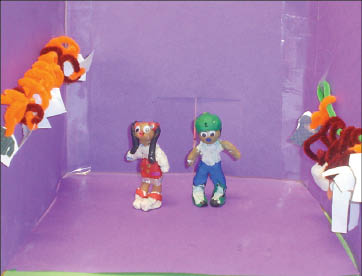 |
|
Get animated: Clay and cameras enable youths at Atlanta After-School All-Stars to create clay animation projects. Photo: Atlanta After-School All-Stars
|
OK, so you have computers in your after-school program. Now, what do the kids do with them?
If they do some Web research and play games – even off-the-shelf math and language games – that’s fine. But many after-school programs are getting more innovative, finding ways to teach their youths significant technological skills.
Youth at these programs start blogs, create animation, use digital cameras and camcorders to make electronic scrapbooks and movies, and build their own games.
“Our model is to use technology to offer an outlet for self-expression,” says Lilian Nuñez at CentroNia, a bilingual after-school program in Washington, D.C. “Not only has it given students increased awareness in the technological field, but it has enabled them to learn about their own cultures.”
Don’t forget: Although talk of the digital divide has subsided in recent years, as more and more households, schools and youth programs get computers, that divide “is still out there,” says Trudy Dunham, research fellow at the University of Minnesota’s Center for 4-H and Community Youth Development. Even with computers around them, youth in poorer communities often don’t have the access or the training available to others.
Dunham notes that technology is an important tool not only for education, but for youths to navigate their world. “It lets them participate more fully in their culture,” she says. “Building MySpace pages, downloading music, doing online research – it allows kids to stay up with their peer group, as well as helping them prepare for college and the work force.”
Dunham says that using computers to do homework or play games does little to promote a youth’s understanding and effective use of technology. “You have to make it meaningful,” she says.
And fun. “You have to recognize that between sports and homework, sometimes kids just want to hang out,” says Erika Thiel, program coordinator for Explore 4-H Afterschool Fun in Bonners Ferry, Idaho. “We don’t want to make it stressful.”
Therein lies the challenge for after-school programs. It’s true that just providing computer access draws kids off the streets and into programs, says Nuñez at CentroNia. The challenge is to set up activities that are constructive, but don’t feel like more school work.
One approach that’s perfectly suited for after-school programs is to combine technology with art, self-expression and creativity. At 5th Dimension, an after-school program in Watauga County, N.C., youths can’t play games on the computers, but they can create their own games and share them with others. Almost every youth has a college-age mentor who works as a partner on digital projects.
That human connection is an easy element to overlook in a tech program, but agency administrators say it is no less essential than in any other form of youth work, such as recreation or art.
“Relationships matter between staff and students,” says Catherine Jordan, project manager for the National Partnership for Quality After-School Learning at the Southwest Educational Development Laboratory in Austin, Texas. “What attracts kids and keeps them coming is an adult who cares about them.”
The YouthLearn Initiative – a pilot project of the Washington-based Morino Institute, which helps youth development programs apply technology to education – has confirmed this in its own research, pointing out that meaningful relationships with both adults and other children is key, regardless of how much access kids have to technological tools. CentroNia is one of the programs that YouthLearn assisted.
“These kids don’t always have someone at home they can talk to,” says Jessica Spears, the lead site coordinator at 5th Dimension. The mentors create “a ‘friend’ relationship. The kids get very comfortable with their mentors, and some of these relationships last beyond the after-school program.”
There are, however, several challenges for after-school computer initiatives.
YouthLearn’s research shows that youth workers need to be well-versed in technology before exposing children to it. Jordan, of the Southwest Educational Development Laboratory, says one of the biggest problems with technology programs in after-school programs can be adults who don’t know the technology themselves.
She says that’s why older students can be great mentors or teachers in these programs: They’ve usually grown up using technology and are comfortable manipulating digital tools and learning new software. Thiel’s 4-H after-school program, for example, uses high school volunteers to work with kids.
Another key, according to Jordan, is variety: giving kids access to all kinds of technology, such as digital cameras, computers, GPS systems and robotics. In Chicago, Cabrini Connection uses blogs to provide access to videos that the youths create about their lives, including what it’s like to live in the notorious Cabrini Green area of Chicago. This gives the kids an opportunity not only to be creative with technology, but also to share their messages with others.
As for one of the most basic issues – getting computers – many agencies raise funds to buy their own, but others set up their programs in schools, using computers that are already there. That raises the promising but sometimes touchy matter of using school space, equipment and even teachers or volunteers. “Having the school district’s support has been our mainstay,” says Thiel at Explore 4-H Afterschool Fun. “If we had to pay for a facility and computers, we wouldn’t have a program.”
The programs on the following pages serve a variety of youth populations, using various approaches to creative expression through technology.
Deborah Huso is a freelance writer in Blue Grass, Va. dhuso@youthtoday.org.
Atlanta After-School All-Stars
Atlanta, Ga.
(404) 413-8355
http://www.atlantaafterschoolallstars.org
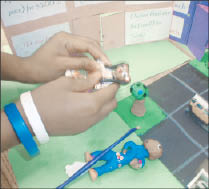 |
|
Taking shape: A youth works on clay animation. Photo: Atlanta After-School All-Stars
|
The Approach: The technology component of Atlanta’s After-School All-Stars, called Miracles, is open to only 40 youths a year, so kids must apply to join. All-Stars gives presentations to parents at PTA meetings, and the parents and youths must to fill out applications. “If the parent isn’t committed, the kid won’t be,” says Associate Executive Director Lyndsy Greene.
Sixth-graders participating in Miracles begin by learning to use Microsoft programs, and eventually move on to Web design. In between, they learn to use digital cameras in clay animation projects.
The youths can do clay animation about any subject, as long as it’s positive, and must work in groups. The projects usually take about a month to complete, and culminate in a 30-second video. Some have been about fun activities like basketball, but last year several youths created a movie about combating bullying.
Seventh-graders learn robotics, while eighth-graders learn video production, including how to run a camera, write a script and produce a movie.
Greene says the education in technology will boost the youths’ future prospects. “Everything we do is going to be technology-based in the coming years,” she says.
Equipment: The sixth-grade lab has 19 computers, while the seventh- and eighth-grade labs share 20 computers. Kids also have access to four digital cameras.
History and Organization: The All-Stars programs began in the 1990s as Inner City Games and focused on sports, then expanded to other cities, shifted more toward academics and adopted the new name. (See “Arnold Learns Youth Work,” October 2003.)
The Atlanta program, part of the national network, began in 1996 as a summer Olympics program and expanded to year-round. The after-school program began in 2003 at King Middle School, which is the only place where Miracles is offered.
Youths attend five days a week, three hours a day.
Youth Served: 40 per year. Atlanta After-School All Stars, which serves 1,600 youth per year, says more than 95 percent of its participants are on free or reduced lunch programs.
Staff: One school teacher and three Georgia State University students.
Funding: Miracles costs $100,000 annually. All funding is provided through the Todd Wagner Foundation.
Indicators of Success: After-School All-Stars does not conduct any longitudinal studies on impacts after ninth grade, but the program says it shows immediate impacts on kids’ test scores, grade-point averages and school attendance. Last year, for example, eighth-graders at King Middle School who participated in All-Stars averaged 11 points higher than non-participants on the math portion of a key standardized state test, and 10 points higher on reading and language arts. Last year’s All-Star participants at King had higher grade-point averages than non-participants at the same school. The assessments did not isolate youths participating in Miracles.
CentroNia
Washington, D.C.
(202) 332-4200
http://www.centronia.org
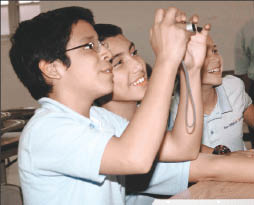 |
|
Communication Tools: Youth at CentroNia learn to use digital cameras to make documentaries about their lives. Photo: CentroNia
|
The Approach: CentroNia strives to provide technology access and education to at-risk youth who probably don’t have access to computers at home or easy access at school. Youth Program Coordinator Manuel Mendez says the technology component of CentroNia’s after-school program teaches the basics of using Macintosh computers, as well as software programs like PhotoShop, iMovie and Movie Maker. Kids also learn how to keep diaries and photographs on their own blogs.
The program reaches beyond software skills and teaches young people to use technology to communicate, reach out to others and improve their lives. For example, the after-school program has a Youth Book Club in which youths use http://www.blogger.com to write entries about their readings and their activities related to the books they read.
Kids also learn to use digital cameras and manipulate their photos in PhotoShop, and to make documentary movies. Last year, participants made a movie about what would happen if Barack Obama became president, and also about the problem of pregnant teens dropping out of school.
“A lot of our kids are from disadvantaged homes, so the majority don’t have computers of their own,” Mendez says. “This is their only opportunity besides school.”
Equipment: CentroNia has 16 desktop computers in its lab and 16 wireless laptops. The program also has dozens of digital cameras and a couple of video cameras. Youths also learn to use film cameras, and to develop black-and-white film in a dark room.
History and Organization: CentroNia began two decades ago as the Calvary Bilingual Multicultural Learning Center, a church-based child care and education program for the lower-income families of its community, many of whom speak English as a second language. In 1995, CentroNia moved from the Calvary United Methodist Church to a new location, to reflect its accessibility to all families in the neighborhood, not just church members.
CentroNia was selected for the Morino Institute’s Youth Development Collaborative Pilot from 1998 to 2000, which helped to bring technology to after-school programs. Today, technology is fully incorporated in the agency’s after-school activities.
Youth Served: The after-school program serves about 200 children each year, ages 6 to 18. Most are from neighborhoods with many Spanish-speaking children from immigrant families. Children participate in the after-school program for three to four hours each day.
Staff: The after-school program has three full-time employees.
Funding: CentroNia takes in more than $1 million annually; most of that money goes to its public charter school. Funders that support the technology aspect of the after-school program include the city’s Department of Human Services, the Children and Youth Investment Trust Corp., Serve DC, NBC Universal, Newcomers, the Shippy Foundation and federal 21st Century Community Learning Center grants.
Indicators of Success: Mendez says CentroNia has only recently started working on gauging formal outcomes, but staffers go to area schools to see how participants are doing in their school work. The Doris Duke Charitable Trust has recognized CentroNia as one of the top 21 child development centers in the country.
5th Dimension
Boone, N.C.
(828) 719-0965
http://www.ced.appstate.edu/projects/5d
The Approach: While 5th Dimension (aka 5th D) focuses on teaching kids to use computers, video, digital cameras and robots, administrators say its most crucial aspect is building one-on-one relationships. Each youth participant is paired with a mentor who is majoring in education at nearby Appalachian State University (ASU). The college students participate in the program to fulfill requirements for service hours.
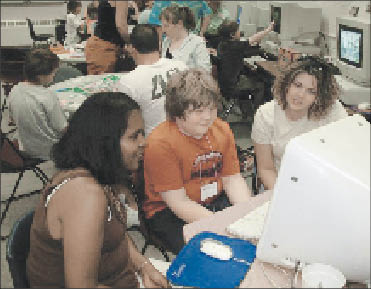 |
|
Gathering ’round a project at 5th D. Photo: 5th Dimension
|
“Mentors learn how to use the technology themselves, and then they teach the kids,” says Jessica Spears, the program’s lead site coordinator. The program runs at several schools and at ASU. The children meet after school twice a week.
Each semester, a mentor and youth complete a technology project together. The projects range from movie-making and slide shows to PowerPoint presentations and electronic scrapbooks. One youth worked with her mentor to learn to play the recorder, and documented her lessons and progress through a digital portfolio. Another took up-close pictures of objects around his school, and created a game in which other kids had to guess what the images were.
Spears thinks the one-on-one relationships make a big difference. “Learning together is better than just playing,” she says. “It’s different from learning in a classroom of 30 to 40 kids. It makes the learning process easier.”
Equipment: Each of the six 5th D sites in Watauga County has about 10 computers available, all of which are owned by the school in which the after-school program takes place. 5th D also owns seven Macintosh computers and has access to five personal computers owned by ASU. The program has three digital cameras and three video cameras, which are shared among the sites.
History and Organization: “5th D” began at the University of California in 1986, under the direction of education professor Bill Blanton. Since then, after-school programs across the country have replicated it, including ASU’s Reich College of Education.
Each 5th D site is affiliated with a university and incorporates technology. The university affiliation usually involves the participation of college students in the after-school programs.
Youth Served: 5th D runs at five elementary schools in Watauga County and on the ASU campus, where it serves mostly the children of faculty members. The program is open to youths in kindergarten through fifth grade. In the 2006-07 school year, Watauga County’s 5th D served 84 children.
Staff: 13 employees, including two site coordinators at each location, and up to 175 volunteer mentors, all of whom are education students at ASU.
Funding: The annual budget of $35,000 is funded by ASU’s Reich College of Education and federal 21st Century Community Learning Center grants.
Indicators of Success: Spears says 5th D has not conducted longitudinal studies on its impact. She says the most common improvement noted by teachers is the participants’ classroom behavior. Spears notes many of the participants do not live with their parents, or live with working single parents who don’t have much time to spend with them, and develop close relationships with their mentors.
Explore 4-H Afterschool Fun
Bonners Ferry, Idaho
(208) 267-3235
http://extension.ag.uidaho.edu/boundary
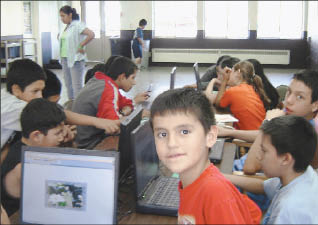 |
|
The next Wallace and Grommit movie might be in the works at 4-H, where youths work on their computer projects. Photo: University of Idaho Extension
|
The Approach: This program uses technology to help elementary school youths explore and create art. Program Coordinator Erika Thiel was an art major in college. The youths use Tech4Learning software, including ImageBlender and VideoBlender, to create clay animation videos.
Kids also learn art history by choosing an artist whose work they have seen and like, performing research on the artist using the Internet, and finding the museums in which his or her work may be found around the world. The program also covers image manipulation. Thiel says the youths take pictures of themselves to create a digital storybook.
Even while using technology, however, the youths conduct projects that encourage them to get on their feet. Last year, they used pedometers to track how much they walk in a day, and the after-school program as a whole walked the equivalent of the distance from Bonner’s Ferry, Idaho, to Disneyland in California. The kids then made Disney animation movies as a reward, creating their own sculptures, adding music and creating backgrounds. They invited their parents in for a movie night, complete with popcorn.
The youths have also used GPS systems to run scavenger hunts in a local wildlife refuge.
Thiel thinks art and technology are a great combination. “It gets kids interested in art and the Internet,” she says. “It’s not like doing school work, but it fosters interest in art.”
Equipment: A mobile lab with 10 computers belonging to the University of Idaho’s District I 4-H office is available to after-school programs throughout the Idaho Panhandle. The Bonner’s Ferry program has two laptops and a digital camera of its own, and is applying for grants to increase the availability of computers.
History and Organization: The 4-H after-school program in Boundary County began 10 years ago and is run by the University of Idaho Extension program. Designed to accommodate the county’s four-day school week, it runs each Friday for 10 hours. It is held at the Boundary County Middle School, so the program can use the school library.
Youth Served: About 50 youths from four elementary schools. The program is open to any youth from those schools.
Staff: The program uses three adult full-time staffers, two high school student workers and up to 30 volunteers. Most of the volunteers are high school girls who participate in Boundary County’s Junior Miss Pageant.
Funding: 4-H Afterschool Fun’s annual budget is $23,000. Some of the funding comes from participation fees of $10 per week per youth. The program has also received mini-grants from the Idaho State 4-H program, Operation Military Kids, the Idaho Community Foundation, and Engaging Youth, Serving Communities.
Indicators of Success: While the Friday 4-H after-school program has not evaluated its technology component, it did complete a survey in 2005 of its after-school program overall. Eighty-three percent of kids responding said they felt the after-school environment was safe, while 81 percent said it provided an opportunity to establish relationships with adults. Seventy-two percent said they found the activities challenging and felt they could be themselves.



































